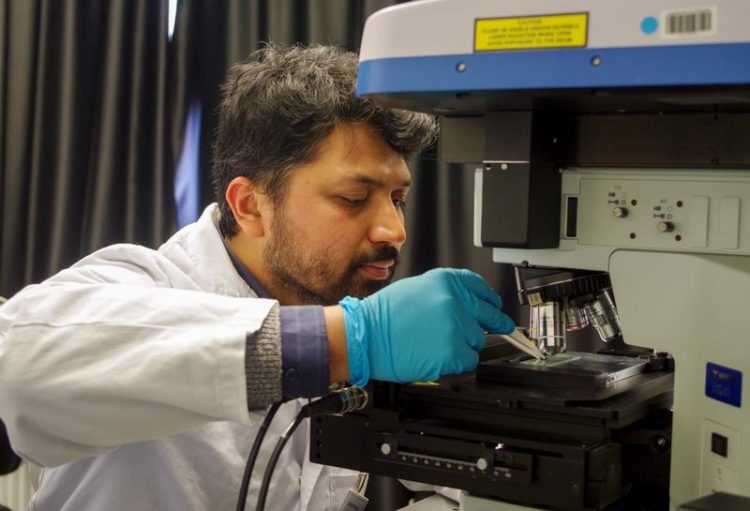Highlight in Semiconductor Research

TU researcher analyzes ultrathin gallium(II) selenide using Raman spectroscopy. Photo: Lars Meese
With his scientific article entitled “GaSe oxidation in air: from bulk to monolayers,” Mahfujur Rahaman has made an important contribution to physics research in the field of semiconductors. Rahaman is a doctoral candidate in the Professorship for Semiconductor Physics (Prof. Dr. Dietrich R.T. Zahn) at Chemnitz University of Technology.
His work was recognized as one of the highlights of 2017 by “Semiconductor Science and Technology,” a scientific journal specializing in semiconductors and their application. The jury evaluated his study according to various criteria, including presentation of outstanding research, popularity with online readership and high praise from referees.
With his scientific work, the TU researcher has opened the door to an even better understanding of ultrathin GaSe material and has thereby made an important contribution to the development of new GaSe-based technologies in nanoelectronics. “I feel very honored to receive this recognition and that my work is nominated as one of the best among so many outstanding scientific publications in this journal,” said the Chemnitz-based physicist proudly.
Important contribution to understanding of ultrathin GaSe materials
Two-dimensional semiconductors have undergone rapid development in recent years and possess great potential to replace current state-of-the-art silicon-based components- and thereby herald a new era in nanotechnology. Particularly from an economic perspective, two-dimensional semiconductors are very much in demand:
“These materials are thinner than the silicon that is commonly used and also less expensive. Apart from that, they also exhibit higher electron mobility,” explains Mahfujur Rahaman.
For this reason, he is conducting research on the physical characteristics of gallium(II) selenide (GaSe) – a highly promising two-dimensional semiconductor – under the direction of Prof. Zahn. Using three different spectroscopic techniques – Raman spectroscopy, photoluminescence and X-ray photoelectron spectroscopy – the physicist studies the properties of single- and multi-layered GaSe. The material, with a thickness of approximately one nanometer, is around one hundred thousand times thinner than a human hair.
Rahaman’s study showed that a single layer of the chemical compound oxidizes immediately when exposed to oxygen. However, when more than three layers are used, all GaSe layers beyond the third are protected from oxidation and remain stable.
More information is available from Mahfujur Rahaman, phone 0371 531-33298, e-mail mahfujur.rahaman@physik.tu-chemnitz.de and Prof. Dr. Dietrich R.T. Zahn, phone 0371 531-33036, e-mail zahn@physik.tu-chemniz.de
Media Contact
More Information:
http://www.tu-chemnitz.de/All latest news from the category: Physics and Astronomy
This area deals with the fundamental laws and building blocks of nature and how they interact, the properties and the behavior of matter, and research into space and time and their structures.
innovations-report provides in-depth reports and articles on subjects such as astrophysics, laser technologies, nuclear, quantum, particle and solid-state physics, nanotechnologies, planetary research and findings (Mars, Venus) and developments related to the Hubble Telescope.
Newest articles

High-energy-density aqueous battery based on halogen multi-electron transfer
Traditional non-aqueous lithium-ion batteries have a high energy density, but their safety is compromised due to the flammable organic electrolytes they utilize. Aqueous batteries use water as the solvent for…

First-ever combined heart pump and pig kidney transplant
…gives new hope to patient with terminal illness. Surgeons at NYU Langone Health performed the first-ever combined mechanical heart pump and gene-edited pig kidney transplant surgery in a 54-year-old woman…

Biophysics: Testing how well biomarkers work
LMU researchers have developed a method to determine how reliably target proteins can be labeled using super-resolution fluorescence microscopy. Modern microscopy techniques make it possible to examine the inner workings…





















